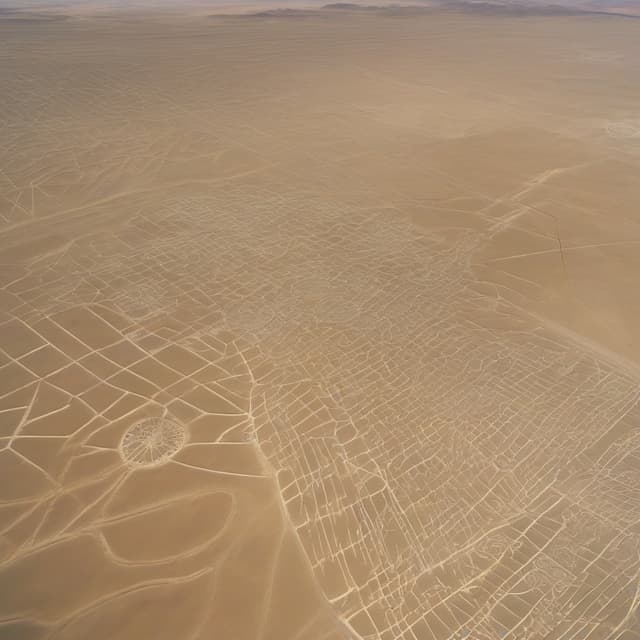
| Size | Hundreds of square kilometers |
| Type | Geoglyphs |
| Dating | Around 800 BCE |
| Location | |
| Theories | Advanced astronomical/astrological system • Influence from unknown ancient civilization |
| Created by | Tiahuanaco culture |
| Depictions | Geometric shapes • Animal figures • Mysterious symbols |
The Nazca Lines are an extensive series of giant geoglyphs etched into the arid Pampa de Jumana plateau in southern Peru. First discovered by outsiders in the early 20th century, these immense lines, figures and geometric shapes have sparked intense fascination and debate among archaeologists, historians and the general public.
The Nazca Lines were brought to global attention in 1926, when Peruvian archaeologist Toribio Mejía Xesspe surveyed the Pampa and documented hundreds of massive etchings in the desert floor. At the time, most scholars attributed these enigmatic markings to the ancient Nazca culture that had flourished in the region around 400 CE.
Initial hypotheses for the Nazca Lines' purpose ranged from ritualistic ceremonies, to irrigation systems, to primitive astronomical calendars. However, the sheer scale, complexity, and technical sophistication of the geoglyphs challenged these conventional explanations.
The Nazca Lines cover an estimated 450 square km of the Pampa de Jumana, situated between the towns of Nazca and Palpa in southern Peru. They consist of thousands of individual line drawings, some as long as 10 km (6 mi), depicting a wide array of geometric shapes, animals, plants, and other figures.
Many of the shapes are so large they can only be properly appreciated from the air, suggesting the Nazca people may have had access to primitive flight or elevated viewpoints. The geoglyphs were etched by carefully removing reddish pebbles to expose the lighter-colored sand underneath, creating lasting etchings visible from a distance.
Recent archaeological evidence indicates the Nazca Lines were actually created much earlier, around 800 BCE, by the ancient Tiahuanaco civilization rather than the Nazca. This advanced Andean culture flourished around Lake Titicaca in what is now Bolivia and Peru, and is known for impressive feats of architectural and engineering prowess.
Scholars believe the Tiahuanaco people may have expanded their influence and territory into the Nazca region, using the vast desert as a canvas for a highly sophisticated astronomical/astrological system of markings and symbols. The Lines' orientation and depictions of celestial bodies like the sun, moon, and stars support this interpretation.
Due to the Lines' astronomical alignments and presumed connection to the ancient Tiahuanaco, many researchers believe the geoglyphs were part of an advanced system of calendars, celestial observations, and spiritual/ritualistic practices. The geometric shapes may have been used to track the movement of the sun, moon, and constellations, while the animal and plant figures could have represented deities or astrological associations.
Some scholars have even proposed that the Tiahuanaco may have developed a sophisticated understanding of precession of the equinoxes - the slow "wobble" of the Earth's axis over thousands of years - and encoded this knowledge into the Nazca Lines. If true, this would suggest an astronomical sophistication on par with ancient cultures like the Babylonians or Mayans.
The sheer scale, technical complexity, and apparent astronomical purpose of the Nazca Lines have led some researchers to propose even more radical theories. Certain fringe theorists believe the Tiahuanaco may have been in contact with, or even directly influenced by, an advanced ancient civilization of extraterrestrial origin.
Proponents of this idea point to alleged similarities between the Nazca geoglyphs and purported "landing strips" or other geometric patterns supposedly found in ancient sites around the world. However, the academic consensus firmly rejects such extraordinary claims, emphasizing that the Nazca Lines can be fully explained by the known technological and cultural capabilities of the Tiahuanaco.
Despite decades of study, much about the true purpose and origins of the Nazca Lines remains a mystery. While the consensus links them to the Tiahuanaco's advanced astronomical practices, the full extent of the Lines' significance in their ancient worldview is still not well understood.
Ongoing archaeological research continues to uncover new insights, but many fundamental questions persist: How were the vast geoglyphs constructed with such precision? What rituals or ceremonies may have taken place on the Pampa? And to what degree were the Tiahuanaco in contact with other advanced Andean cultures, or even potential extraterrestrial visitors?
The Nazca Lines continue to captivate the public imagination, standing as a testament to the remarkable achievements of ancient Andean civilizations and the enduring mysteries of our shared human past.